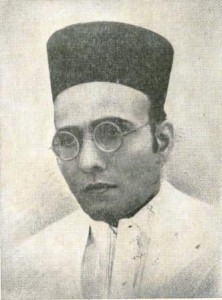For most Indians of my generation, Savarkar is a somewhat shadowy figure – rarely mentioned in any detail in history books; even less so at public events or occasions that commemorate India’s independence. For a small few though, he is the archetypical hero – the one who fought fearlessly against the British, the “Veer” (brave).
As some of you would know, by the time India became a republic in 1950, Savarkar was already on the path to oblivion. A few years later, he died – unsung and hardly mourned. In the 45 years since, he has become a deeply polarising figure in the pantheon of leaders who fought for India’s Independence.
I had long wanted to read more about him…but something or the other always prevented a detailed research. In the meantime, I stumbled on this piece by Sh Arvind Lavakare – and felt this was as good a place to start. On this occasion of his 128th birth anniversary, I hope to begin a re-examination of this great historical figure. Today, excerpts from “A Saint vs. A Patriot” by Sh Lavakare (emphasis added):
The life of Savarkar (1883-1966) was so uniquely variegated that it is almost unbelievable that one individual could possess such an intellect, such talent, such intensity as to be a firebrand freedom fighter from childhood, a potential barrister, a writer of history, of poetry and Sanskrit prayers, a social reformer, and a distinctive political ideologue with a prophetic vision on the fate of Kashmir, the formation of Pakistan along with its subsequent hostility, the mass Muslim infiltration from East Bengal into Assam and China’s hoodwinking Nehru on his Panchsheel.
He suffered six months of solitary confinement, seven days standing handcuffed, ten days of cross bar fetters and other tortures in the cellular jail on the infamous Andaman islands of old where he was sent in 1911 to serve a total of 50-year life imprisonment for his alleged involvement in two cases: the murder of the English district magistrate of Nashik and efforts in Bombay to ‘overthrow the legally formed government of the country.‘ He was in the Andaman prison till 1921, from where he was shifted first to Alipore jail and then, in January 1924, released from prison but confined in his movements to Ratnagiri district (in present Maharashtra) with stringent conditions. It was in May 1937, when Jamnadas Mehta of the Tilak Democratic Swaraj Party agreed to support the new Cooper ministry in Bombay on the express condition of Savarkar’s unconditional release, that Savarkar was finally rid of colonial shackles. And he soon plunged into politics, becoming the president of the Hindu Mahasabha, even as those engaged in the freedom movement sought his views and advice. Included in that lot was Subhas Chandra Bose whom he inspired to make India free through military action.
…
But the Congress and Communists of 2003 are not moved by all that Savarkar did or suffered in trying to win freedom for his beloved country, by how Savarkar kindled the minds and hearts of millions, including Bose and Bhagat Singh.
Image courtesy: www.Savarkar.org
Regarding Savarkar’s connection with Godse, the Special Court appointed for the trial did not accept the evidence of Digamber Badge who had turned approver and stated that Savarkar had blessed the assassins in their mission. In Godse’s reply to the charge sheet against him — reproduced fully in May it Please You Honour (Surya Bharti Prakashan, New Delhi, 1987) — he had categorically denied the prosecution’s stand that he was guided in his action by Savarkar and that, but for Savarkar’s complicity, he could not have acted the way he did. What’s more, Godse’s reply stated ‘I take the strongest exception to this untrue and unjust charge and I further regard it as an insult to my intelligence and judgement.’ (Ibid page 45). Indeed, Godse’s reply indicated his disenchantment with Savarkar’s belief that free India having got its own government, all parties should conduct their propaganda on constitutional lines rather through anarchical tactics and undemocratic conduct. (Ibid page 56).
‘Let the Indian State be purely Indian. Let it not recognise any invidious distinction whatsoever as regards the franchise, public services, offices, taxation on the grounds of religion and race. Let no cognisance be taken whatsoever of a man being Hindu or Mohammedan, Christian or Jew. Let all citizens of that Indian state be treated according to their worth irrespective of their religion or racial percentage in the general population.’
